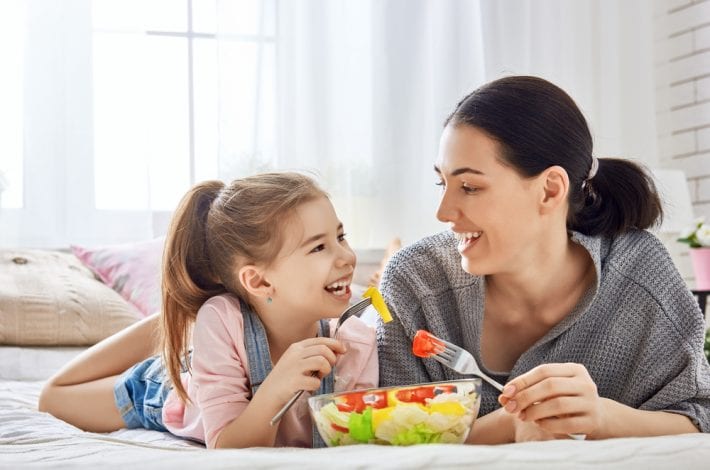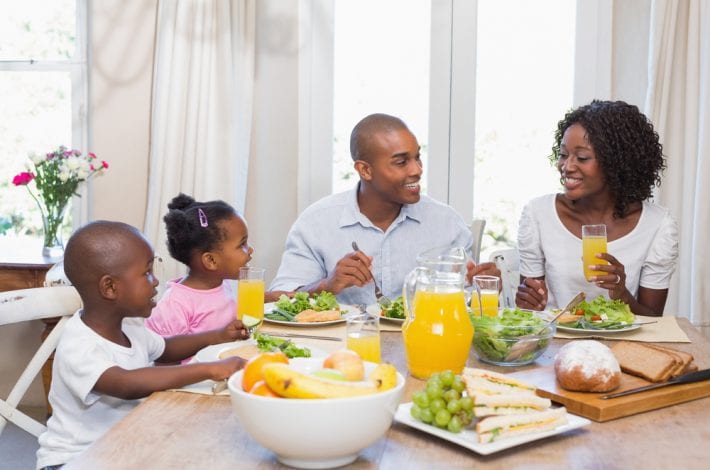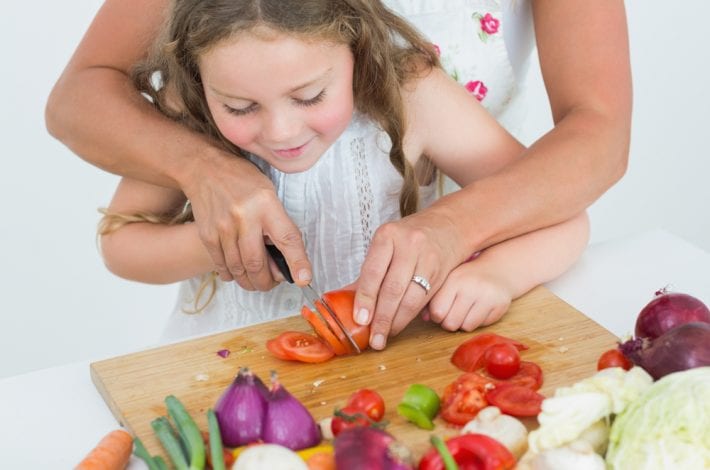

With children as young as three labelling themselves ‘fat’, how can we protect our little ones from developing anxiety about the way they look? How can we encourage a positive body image in our children?
A study conducted by the Professional Association for Childcare and Early Years found that having a negative body image can develop at the tiny age of three or four. The research also uncovered that a third of nursery school staff have heard children this age label themselves as ‘fat’.
It’s awful to think of our children criticising their bodies at any age, let alone when they’re still babies in our eyes. As parents, we want to get inside their tiny minds and ensure that there’s only happy thoughts and positive messages. We’ve put together some tips to encourage good thoughts about the way they look and healthy eating.


Ooh-bi-doo, I wanna be like you oo oo
We all want to set the perfect example for our kids. But when we’re in the thick of it with the daily grind, the idea of being a positive person at all times isn’t always at the forefront of our minds.
In a digital era, we also now have social media and airbrushed ‘influencers’ who always appear a million times better than we do. This can make us all fixated about the way we look, sometimes without even realising it.
On those rare days that we get a moment to look at ourselves in the mirror, we might look critically at our hips or our mum-bellies and mutter our thoughts to ourselves, thinking no one is listening. But often they are.
Try to be aware of little things you say and to avoid appearing unhappy when you do look in the mirror. You can even do a little boogie, to make looking in the mirror less serious and more fun!
It all helps to encourage a positive body image in our children.


Ditch the diet chat
Negativity around food often stems from the pressure to be thin, which many people believe is achieved through diets and strict exercise regimes.
A lot of us are guilty of saying we need to go to the gym more or talking about how great the latest fad diet is. Avoiding these conversations in front of your children might not be easy if you have a gym-bunny sibling or healthy eating guru friends. Instead you could change the way you talk about food.
The ‘food substitute shakes that make us really thin’ could be ‘the milkshakes that are so tasty and make us really strong’.
Another habit that a lot of us tend to slip into is labelling certain foods as being ‘good’ or ‘bad’. Instead of doing this you could focus more on why we eat what we eat.
Maybe you’re in a restaurant setting with your mother-in-law and she says she’s eating a salad because she’s trying to be ‘good’. Instead she or you could say ‘nannie is eating salad today because it’s got lots of vitamins and minerals to make her feel great.’


Teach them ‘looks aren’t everything’
Encouraging a positive body image in our children is all about challenging assumptions that children often develop as they are exposed to more messages.
Every so often you could ask your child’s opinion on a character or person, to see how their thoughts on slimmer and larger people are developing. If they tap into appearance, maybe try and focus their attention away from the physical ‘look’ of someone and more towards their personality and talents.
You might have an older relative who is slightly larger in size. If they talk about ‘grandad’s big tummy’ you could steer the conversation towards ‘how funny are grandad’s jokes?’ or ‘it doesn’t matter what grandad looks like, remember how great he was at fixing our fence and teaching you to play dominos?’
Even kids’ TV shows and movies are guilty of describing certain people as ‘fat’ and painting a negative picture around characters with a larger belly. If you happen to spot this, you could remind your children that people come in all shapes and sizes. That’s what makes us all unique, which is an amazing thing.
Or you could tap into their empathetic side. If they witness a comment that is picking on people for being bigger you could ask, ‘how would you feel if someone teased you like that?’


Make being healthy fun
Try not to let being healthy become a chore for yourself as well as your children. If you enjoy something, your children are much more likely to pick up on this and follow suit.
As we creep into the cooler months there are of course days where we just want to curl up on the sofa with some chocolate.
We all need a treat or an afternoon of Sunday baking with the kids. And we shouldn’t feel that we can’t do these things. If anything they teach children that it’s OK to eat ‘less healthy’ foods occasionally.
However, we can also involve children in preparing healthy foods and make it a fun activity to do altogether. You might want to take them to the supermarket or to the farmer’s market with you and have them pick out the fruits and vegetables that they would like. You may find that they end up eating and enjoying vegetables that they wouldn’t touch with a barge pole the day before.
You could also include the children in preparing healthy meals. Little hands can get in the way and be anything but helpful sometimes. However, it’s a great opportunity to start talking about the different foods and why we love them.
‘Fruit and vegetables give us the vitamins and nutrients we need, while meat gives us protein and energy’. Not all vegetables are bland in taste either, talking about delicious sweet potatoes, peppers, butternut squash and parsnips all give positive messages about healthy foods.
As a happy, healthy family, it’s all about using the power of positivity and most importantly, focusing on the fun (as much as we can!).






